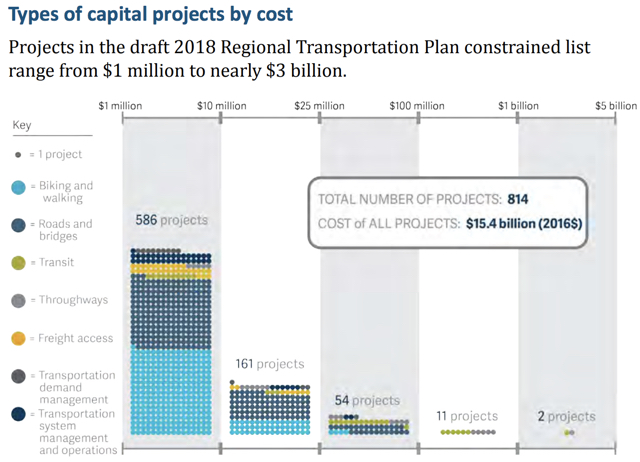
“While this plan isn’t the best we can do, it reflects the best we can do right now.”
— from Metro’s RTP Formal Comment Period Briefing Book
When it comes to major infrastructure projects, if it’s not in Metro’s Regional Transportation Plan (RTP), it’s not going to be built. And as our region faces growing population pressure, a mobility revolution, and the impacts of climate change, it’s imperative that the projects listed in this plan reflect our highest values and priorities.
For the past three years Metro and their partners have been working to update the RTP and we’re now just five months away from formal adoption. But before that happens, councilors and policymakers need to hear what you think. An official public comment period is now open and runs through August 13th.
The RTP includes over $42 billion of investment in the regional transportation system over the next 25 years split between $27 billion for maintenance/operations and $15 billion for capital projects.
Here’s more from Metro’s website:
The Regional Transportation Plan is a blueprint to guide investments for all forms of travel – driving, walking, biking and taking transit – and moving goods and services throughout the greater Portland region.
The updated vision for the future represents an aspirational view and reflects the values and desired outcomes expressed by the public, policymakers and community and business leaders.
Vision: By 2040, everyone in the greater Portland region will share in a prosperous, equitable economy and exceptional quality of life sustained by a safe, reliable, healthy and affordable transportation system with travel options.
It’s no surprise that we need more resources to achieve everything we need to keep this region a great place. While this plan isn’t the best we can do, it reflects the best we can do right now and moves us closer to our vision for a safe, reliable, healthy and affordable transportation system with travel options.
That “isn’t the best we can do” part is curious. It’s almost as if the plan’s authors know it needs to be more bold and less influenced by politicians afraid of rattling the status quo. This is where your comments come in.
Advertisement
The RTP is split into two sections: policies and projects. The policy section defines our values and goals and the project section is meant to be a reflection of them. The project list is separated into two categories: constrained and strategic. The constrained list is where the action is because those are the projects that are more likely to actually be built before 2040. The strategic list are more wishful projects that will require funding beyond what’s projected to be available. Projects are also categorized according to two estimated construction timeframes of 2018-2017 and 2028-2040.
Moving projects between these categories is one of the ways your comments can have a tangible impact on this plan.
Don’t think comments matter? Earlier this year a coalition of advocates expressed major concerns with an earlier version of the RTP project list. Their letter to Metro resulted in major changes.
Here’s how the plan currently doles out the $15.4 billion of constrained projects:

And this chart lays out the projects by volume and cost. (Note how inexpensive the bike/walk projects are and how Metro calls freeways “throughways”.)
A quick look at the interactive map shows some big projects like:
➤ The I-5, I-205, and OR 217 freeway expansions
➤ The Division Transit project
➤ I-5 Bridge replacement to Vancouver (formerly known as the Columbia River Crossing), estimated to cost $3+ billion
➤ Streetcar extension on Broadway to Hollywood Transit Center
➤ SW Corridor Light Rail
➤ NE 42nd Ave Bridge Replacement including bike facilities
Other smaller, yet very important projects on the list include several projects that will improve safety and fill pathway gaps on Marine Drive (we’ll share more about that effort in a separate post).
Metro has several ways you can add your voice to this process: take the online survey, comment in person at the Metro Council meeting tomorrow (Thursday, August 2nd), or send an email to transportation@oregonmetro.gov. To learn more about the RTP, I recommend the helpful “briefing book for policymakers“.
From here, Metro’s advisory committees will draft their own recommendations in October and the full Metro Council will consider adoption of the final RTP in December.
— Catie Gould (@Citizen_Cate) and Jonathan Maus (@jonathan_maus)
Never miss a story. Sign-up for the daily BP Headlines email.
BikePortland needs your support.


